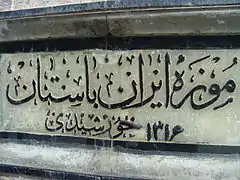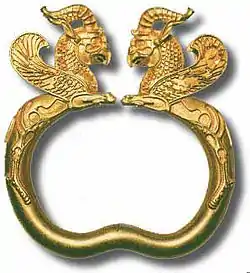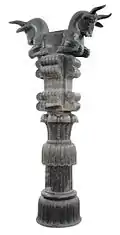موزهٔ ملی ایران Muze-ye Melli-ye Irān | |
 | |
 Museum of Ancient Iran | |
| Established | 1937; 86 years |
|---|---|
| Location | Tehran, Iran |
| Type | Archaeology museum |
| Collection size | +3 million [1] |
| Visitors | 500,000 (2011) [2] |
| Director | Jebrael Nokandeh |
| Owner | ICHTO |
| Website | irannationalmuseum.ir |
The National Museum of Iran (Persian: موزهٔ ملی ایران Mūze-ye Melli-ye Irān) is located in Tehran, Iran. It is an institution formed of two museums; the Museum of Ancient Iran and the Museum of Islamic Archaeology and Art of Iran, which were opened in 1937 and 1972, respectively.
The institution hosts historical monuments dating back through preserved ancient and medieval Iranian antiquities, including pottery vessels, metal objects, textile remains, and some rare books and coins.[3] It also includes a number of research departments, categorized by different historical periods and archaeological topics. National Museum of Iran is the world's most important museum in terms of preservation, display and research of archaeological collections of Iran, and currently displays works that express the richness of culture, civilization, art, economic growth and technological achievements of Iranians.
History
For the first time, the proposal to create a place called "Museum" was made by Morteza Gholi Khan Hedayat.[4] He was thinking of creating a museum and an office called the Department of Antiquities to organize commercial explorations, but he did not achieve this goal. The first museum was established in 1916 under the name of "National Museum" or "Museum of Education" in one of the rooms of the Ministry of Education, which was located on the north side of the Dar al-Funun school building.[5] This museum had 270 bronze artefacts (pottery, glass, coins, old weapons, seals, wooden objects, patches, books and textiles) which were collected by the employees of the Antiquities Department or donated by the people. In 1925, the objects of this museum were moved to the Mirorr Hall at Masoudiyeh Palace.

With the start of excavations by European archaeologists, especially the French archaeological team headed by Jacques de Morgan in Susa (1897) the people's attention was drawn to the importance of cultural heritage. In 1927, the unconditional privilege of the French archaeologists in Iran was canceled. They were allowed to dig only in Susa.[6] Since Iran had decided to establish a national museum and library, the privilege of designing and implementing it was given to France.[7] For this purpose, French architecture Andre Godard came to Iran in 1929 to establish a museum and library and officially started his work.
The brick building of the Museum of Ancient Iran was designed by André Godard and Maxime Siroux in the early 20th century, and was influenced by Sassanian vaults, particularly the Taq Kasra at Ctesiphon.[8] Its construction, with an area of about 11,000 square metres (13,000 sq yd), began in 1935 and was completed within two years by Abbas Ali Memar and Morad Tabrizi. It was then officially inaugurated in 1937.[9]
The Museum of the Islamic Era was later built with white travertine on the grassy grounds of the Museum of Ancient Iran. Firouz Bagherzadeh, director of the Iranian Center for Archaeological Research, hold a series of symposiums on Iranian archaeology in this building. It has gone through quite a few hasty interior changes, and was still being remodeled when the 1979 Revolution swept the country.

While the Museum of Ancient Iran always had a clear mandate to show archaeological relics, as well as some rare medieval textiles and rug pieces, the newer complex began to also feature the exquisite Amlash pottery from prehistoric Caspian Sea regions of Iran. This followed some modern works, and the repeated gutting and remodeling of the interior. The Museum of the Islamic Era exhibits over 1,500 works from Ilkanids, Seljuks, Timurids, Safavids, Qajars and more. The complex consists of three floors, and it also contains various pieces of pottery, textiles, texts, artworks, astrolabes, and adobe calligraphy, from Iran's post-classical era.
.jpg.webp)
The oldest artifacts kept at the Ancient Iran Museum are from Kashafrud, Darband, and Shiwatoo, which date back to the Lower Paleolithic period. Mousterian stone tools made by Neanderthals are also on display at the first hall of the Museum of Ancient Iran. The most important Upper Paleolithic tools are from Yafteh, dating back about 30,000 to 35,000 years. The Museum of Ancient Iran consists of two floors. Its halls contain artifacts and fossils from the Lower, Middle, and Upper Paleolithic, as well as the Neolithic, Chalcolithic, early and late Bronze Age, and Iron Ages I-III, through the Median, Achaemenid, Seleucid, Parthian, and Sassanian eras.
Exhibitions
The ground floor of the newer complex has been dedicated to contemporary exhibitions. Temporary exhibition galleries are featured two or three times annually and usually run for about one to two months. National Museum of Iran has organized a large number of different exhibitions over the years.
To celebrate its 80th anniversary in 2018, the museum hosted 50 masterpieces from the Louvre and the Musée national Eugène Delacroix.[10][11] The exhibition attracted over 250,000 visitors.[12][13]
In 2005–2006, National Museum of Iran and the British Museum held a major exhibition. It was held in collaboration with the Iranian government, which loaned the British Museum a number of iconic artefacts in exchange for an undertaking that the Cyrus Cylinder would be loaned to the National Museum of Iran in return.[14] The planned loan of the Cylinder was postponed in October 2009 following the June 2009 Iranian presidential election.[15] The Cylinder displayed in September 2010 for a four-month period.[16] The exhibition was very popular, attracting 48,000 people within the first ten days and about 500,000 people by the time it closed in January 2011.[17] The ancient Sassanid relief (224 - 651 AD), illegally smuggled to the United Arab Emirates during the Iran-Iraq war (1980-1988), and left there in 2006. The relief was seized in United Kingdom in 2016. Its value at auction could exceed £30m.[18] The Iranian government was tracking the long-missing relief for years. The Guardian reported on April 2, 2023 that the relief had been discovered and confiscated at Stansted Airport near London.[19] The British Museum received permission to display the artifact for a short time, and then returned it to Iran. After 35 years, on June 28, 2023, the Sassanid relief returned to home and a well-received exhibition was held. The Sassanid Soldier is now permanently displayed at the National Museum of Iran.[20]
One of the other successful exhibitions, entitled "Evidence for Two Hundred Thousand Years of Human-Animal Bonds in Iran", ran from August to October 2014.[21] The exhibition was mainly about the relation and coexistence of past human societies and various animal species in Iran, since the late Lower Paleolithic to modern decades.
Departments
| Department | Head |
|---|---|
| Research Group | Yousef Hassanzadeh |
| Paleolithic Department | Fereidoun Biglari |
| Prehistoric Department | Fariba Moejezati |
| Historic Department | Shahram Heidarabadian |
| Islamic Department | Karam Mirzaei |
| Coins and seals Department | Fereshteh Zokaei |
| Inscriptions Department | Sedigheh Piran |
| Conservation Department | Parvaneh Soltani |
| Pottery Department | Omolbanin Ghafoori |
| Osteological Department | Marjan Mashkour |
| Library and archive | Azam Jaloli |
| Exhibitions Department | Nina Rezaei |
| Technical Building Department | Majid Moradi |
| Photographic Studio | Mahbobeh Ghelich Khani |
| Public affairs | Hassan Moradi |
| Legal and International relations | Masoumeh Ahmadi |
Management
| Name | Education/Activities |
|---|---|
| Andre Godard
(1939-?) |
French architect, archaeologist and researcher. Head of the department of Antiquities and Museum of Ancient Iran and the founder of the National Museum of Iran. The designer of: National Library building, the tomb of Hafez, the tomb of Ferdowsi and the tomb of Saadi. The founder of the faculty of Fine Arts in the University of Tehran, and the first manager of this faculty. |
| Suleiman Sepahbodi
(1949-?) |
A archaeologist and one of the members of the Association of Education and Inspection of Antiquities Department. |
| Mehdi Bahrami
(1949-1951) |
PhD degree in archaeology from United States. Activities in the Islamic section of the Berlin Museum, compilations such as Iranian industries and pottery, Gorgan pottery, etc. |
| Mohammad Thaqi Mostavafi
(1951-1955) |
Legal archaeologist, specialist in Achaemenid and Seljuk archaeology. Head of the General Directorate of Archaeology, Head of the Ancient Iran Museum, Head of the National Antiquities Association; publications on the history archaeological culture in Iran. |
| Ali Hakemi
(1955-1966) |
PhD in archaeology. Activities in the historical department of Ancient Iran Museum, exploration committees, publication of the "Shahdad explorations" book which was also published in Italy. Setting up several museums such as Pars Museum in Shiraz and Chehelston Museum in Isfahan. |
| Ezatolah Negahban
(1966-1973) |
PhD in Archeology from the University of Pennsylvania. Rescuing historical sites, establishing the Institute of Archeology at Tehran University, being in the General Department of Archaeology, founding the first independent Iranian excavations in Marlik and Haft Tepe, transforming the educational structure of this field and publishing books at world levels. |
| Abdol-Hossein Shahidzadeh
(1973-1975) |
Studied archeology and art history, graduated from the University of Tehran. Exploring the Sassanid sites of Sondos and the Parthian site in Rostamabad etc. |
| Firuz Bagherzadeh
(1975-1976) |
PhD in archeology and history of Islamic art in France. The first chairman of the UNESCO World Heritage Committee in 1977, proposed the world registration of Persepolis, Chogha Zanbil and Naqsh Jahan Square. |
| Mohammad-Yousuf Kiani
(1976-1978) |
PhD in archeology and art history of the Islamic period from the University of London. Exploration in Gorgan plains, head of Iranian museums, teaching as an assistant professor in the archeology department of Tehran University, publication of more than 30 books in the field of archeology and architectural art and articles in domestic and international forums. |
| Seifollah Khambaghshfard
(1979-1981) |
Archaeologist, researcher and author. Organization and liberation of the Kangavar archaeological collection, member of the prehistoric department of the Museum of Ancient Iran and responsible for the archive of this museum, assistant to Ezatollah Gardhani in the department of the Institute of Archeology of Tehran University, expert in charge of archeology in the Center of Archeology of Iran, activity in the excavations of Marlik, Chirag Ali Tepe in Gilan and etc. |
| Nosratollah Mootamedi
(1981-1982) |
Archaeologist. He was sentenced to pay a fine for the crime of destroying national and historical property and went to prison. |
| Qholamreza Maasomi
(1982-1987) |
PhD in archaeology. Head of the Iranian Archeology Center, publishing books such as Siraf or Bandar Taheri, History of Archeology, etc. |
| Jalil Golshan Bafghi
(1987-1995) |
Master's student in archeology and art history from Tehran University. Research deputy of cultural heritage organization, organizing and reopening parts of the museum that were closed or under renovation. Following up on the case of registering Iranian works in the World Heritage List. |
| Ahmad Tehrani Moghadam
(1995-?) |
Studied archeology from Tehran University. Preparing the ground for the construction and operation of the Museum of Islamic Archaeology and Art of Iran, working in the Iranian Archeology Center, supervising the exploration teams. |
| Mohammad-Reza Kargar
(?-2007) |
Studied archeology at Tehran University. Launching international exhibitions in the world's major museums, signing contracts with the world's major museums. |
| Mohammad-Reza Mehrandish
(2007-2009) |
Bachelor of Literature graduate. Compilation of the draft of the comprehensive plan of the National Museum of Iran, Director of Public Relations of the Cultural Heritage Organization. |
| Azadeh Ardakani
(2009-2011) |
Bachelor of Microbiology. The efforts made by the previous managers for the world registration of the tomb of Sheikh Safiuddin and Tabriz bazaar were completed in this period, the international secretary of the Arya heritage website, the editor of the Parse newspaper. |
| Darius Akbarzadeh
(2011-2015) |
PhD in culture and ancient languages. |
| Jebrael Nokandeh
(Since 2015) |
PhD in archeology from the Institute of Near Eastern Archeology (Berlin). Opening the section related to the prehistoric period, completing the restoration operation of the Museum of Islamic Arts after 9 years, integrating the data of different sections, organizing storage areas and producing different catalogs of the museum's important collections, and holding joint programs between the National Museum of Iran and the largest museums around the world such as Louvre, Museum Island etc. |
Gallery
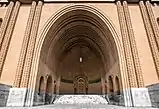 Museum of Ancient Iran, part of the National Museum of Iran.
Museum of Ancient Iran, part of the National Museum of Iran.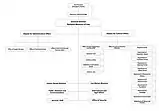 Organizational chart of National Museum of Iran
Organizational chart of National Museum of Iran The entrance of the Museum of Ancient Iran, part of the National Museum of Iran.
The entrance of the Museum of Ancient Iran, part of the National Museum of Iran. Museum of the Islamic Era, part of the National Museum of Iran.
Museum of the Islamic Era, part of the National Museum of Iran.
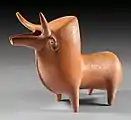 An Iron-Age animal statue from Marlik, kept at the Museum of Ancient Iran.
An Iron-Age animal statue from Marlik, kept at the Museum of Ancient Iran.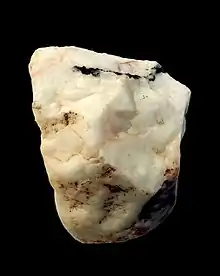 A chopper from the Lower Paleolithic, found at Kashafrud, kept at the Museum of Ancient Iran.
A chopper from the Lower Paleolithic, found at Kashafrud, kept at the Museum of Ancient Iran._Amar_Merdeg%252C_Mehran%252C_Ilam%252C_Lower_Paleolithic%252C_National_Museum_of_Iran.jpg.webp) A trihedral from the Lower Paleolithic, found at Amar Merdeg, kept at the Museum of Ancient Iran.
A trihedral from the Lower Paleolithic, found at Amar Merdeg, kept at the Museum of Ancient Iran.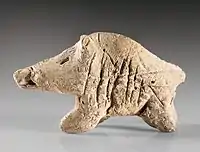 A clay boar figurine from the Neolithic period, found at Tepe Sarab, kept at the Museum of Ancient Iran.
A clay boar figurine from the Neolithic period, found at Tepe Sarab, kept at the Museum of Ancient Iran..jpg.webp) The Saltmen, kept at the Museum of Ancient Iran.
The Saltmen, kept at the Museum of Ancient Iran._Tappeh_Sarab%252C_Kermanshah_ca._7000-6100_BCE_Neolithic_period%252C_National_Museum_of_Iran.jpg.webp) A clay figurine of a fertility goddess found at Tepe Sarab, dating back to the Neolithic, kept at the Museum of Ancient Iran.
A clay figurine of a fertility goddess found at Tepe Sarab, dating back to the Neolithic, kept at the Museum of Ancient Iran.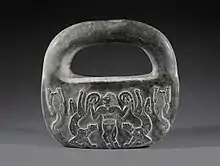 A chlorite object with the Master of Animals motif from Kerman's Jiroft culture, dating back to Bronze Age I, kept at the Museum of Ancient Iran.
A chlorite object with the Master of Animals motif from Kerman's Jiroft culture, dating back to Bronze Age I, kept at the Museum of Ancient Iran. An Elamite bull statue, kept at the Museum of Ancient Iran.
An Elamite bull statue, kept at the Museum of Ancient Iran..JPG.webp)
.JPG.webp) The statue of a Parthian nobleman, kept at the Museum of Ancient Iran.
The statue of a Parthian nobleman, kept at the Museum of Ancient Iran. An Achaemenid mastiff statue, kept at the Museum of Ancient Iran.
An Achaemenid mastiff statue, kept at the Museum of Ancient Iran..JPG.webp) The statue of Darius the Great, kept at the Museum of Ancient Iran.
The statue of Darius the Great, kept at the Museum of Ancient Iran. A statue of a Sasanian nobleman from Hajjiabad, Fars, kept at the Museum of Ancient Iran.
A statue of a Sasanian nobleman from Hajjiabad, Fars, kept at the Museum of Ancient Iran. A 9th-century ceramic bowl from Gorgan, decorated with slip beneath a transparent glaze, designing an anthropic figure with bull head, kept at the Museum of the Islamic Era.
A 9th-century ceramic bowl from Gorgan, decorated with slip beneath a transparent glaze, designing an anthropic figure with bull head, kept at the Museum of the Islamic Era. A 19th-century hookah, kept at the Museum of the Islamic Era.
A 19th-century hookah, kept at the Museum of the Islamic Era._18th_century_CE%252C_Qajar_period%252C_National_Museum_of_Iran.jpg.webp) An 18th-century watercolor painting signed by Abol-Hasan Qaffari (Sani-ol-Molk), from the Qajar period, kept at the Museum of the Islamic Era.
An 18th-century watercolor painting signed by Abol-Hasan Qaffari (Sani-ol-Molk), from the Qajar period, kept at the Museum of the Islamic Era.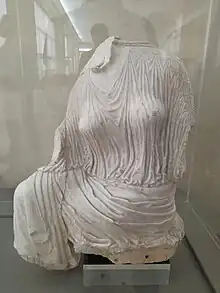 One of the four remaining statues of Penelope was discovered in Persepolis, and is kept at the National Museum of Iran. The other three are at Vatican Museum and Capitoline Museum.[22]
One of the four remaining statues of Penelope was discovered in Persepolis, and is kept at the National Museum of Iran. The other three are at Vatican Museum and Capitoline Museum.[22]
See also
References
- ↑ https://www.farsnews.ir/news/14010401000314/3-%D9%85%DB%8C%D9%84%DB%8C%D9%88%D9%86-%D8%A7%D8%AB%D8%B1-%D8%AA%D8%A7%D8%B1%DB%8C%D8%AE%DB%8C-%D8%A7%D8%B1%D8%B2%D8%B4%D9%85%D9%86%D8%AF-%D8%AF%D8%B1-%D9%82%D9%84%D8%A8-%D8%AA%D9%87%D8%B1%D8%A7%D9%86-%D9%85%D9%88%D8%B2%D9%87-%D9%85%D9%84%DB%8C-%D8%A7%DB%8C%D8%B1%D8%A7%D9%86-%DA%86%D9%82%D8%AF%D8%B1-%D8%AF%D8%B1
- ↑ https://www.economist.com/books-and-arts/2013/03/23/diplomatic-whirl
- ↑ "Otraq.com, Iran's Tourism Guide" Archived 2014-10-20 at the Wayback Machine
- ↑ "مرتضی قلی خان هدایت موسس موزه ملی". Mag Iran. 2023-12-21.
- ↑ "موزه ملی ایران؛ موزه ایران باستان و دوران اسلامی". Safar Market. 2023-12-21.
- ↑ Scheil, V. (2023-12-21). "Excavations made by the French in Susa and Babylonia, 1902-1903". The Biblical World. 24 (2): 146–152. JSTOR 3140967.
- ↑ "The First British and French Archaeological Investigations in Susa during the 19th century". Open Edition Books. 2023-12-21.
- ↑ Sandy Isenstadt, Kishwar Rizvi. Modernism and the Middle East: Architecture and Politics in the Twentieth Century. Studies in Modernity and National Identity. University of Washington Press, 2011. ISBN 0295800305 pp.14
- ↑ Nokandeh, Jebrael (ed.) 2019. A Survey of the History of Iran on the Basis of Iran National Museum Collections, Second edition, Iran National Museum with the contribution of Baloot Noghrei Institute, Tehran
- ↑ "The Louvre at Tehran". Louvre. 2018-06-06.
- ↑ "Louvre show opens in Tehran as cultural diplomacy thrives". The Guardian. 2023-12-20.
- ↑ "The Louvre in Tehran". Euronews. 2018-03-01.
- ↑ "موزه لوور تهران امروز به کار خود پایان میدهد/بازدید ۲۵۰ هزار نفر از موزه معروف فرانسه". Fars News. 2023-12-20.
- ↑ "British Museum in battle with Iran over ancient 'charter of rights'". The Guardian. 2023-12-20.
- ↑ "Historic Cyrus Cylinder called a stranger in its own home". Radio Free Europe. 2023-12-20.
- ↑ "Diplomatic Whirl". The Economist. 2023-12-20.
- ↑ "Cyrus Cylinder warmly welcomed at home". Tehran Times. 2023-12-20.
- ↑ "Smuggled Iranian carving worth £30m seized at airport by UK border control". The Guardian. 2023-12-20.
- ↑ "Sassanid statue back Iran after 35 years". Ifp News. 2023-12-20.
- ↑ "Lost Sassanid soldier". Iran Safar. 2023-12-20.
- ↑ "The Guardian's report about exhibition"
- ↑ "Statue Of Peace, A Journey From Persepolis To Rome And Back (PHOTOS) - Iran Front Page". ifpnews.com. 2015-09-29. Retrieved 2023-12-26.
External links
- Official website of Iran National Museum
- Official website of Journal of Iran National Museum
- Photo Gallery of the National Museum of Iran
- Virtual Tour of Iran National Museum 1
- Virtual Tour of Iran National Museum 2
